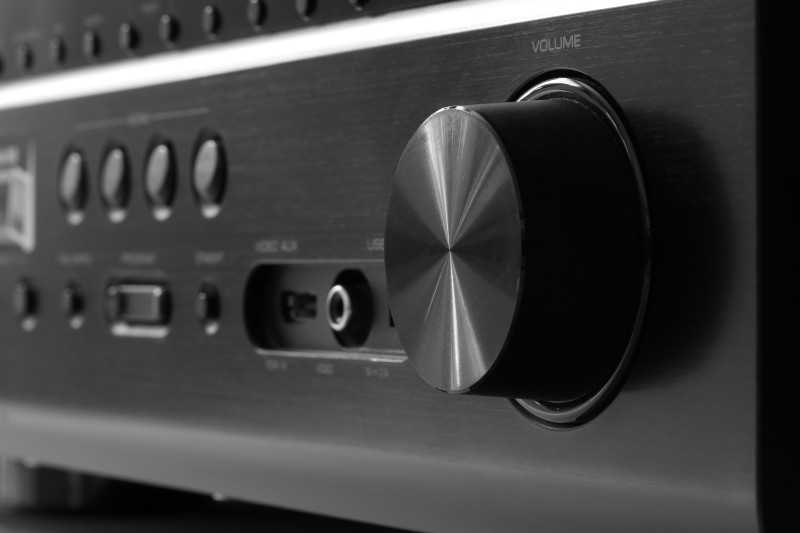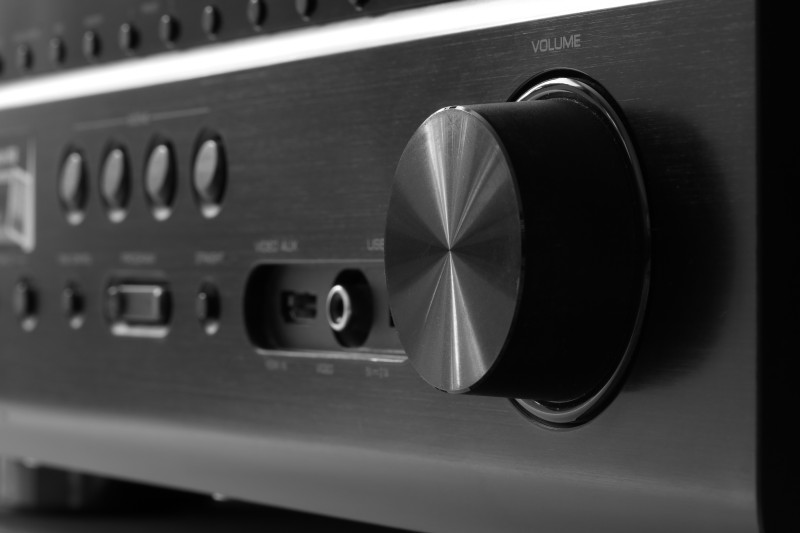How to Choose an AV Receiver (AVR)

Today's AV receivers or AVRs have a come a long way from the stereo era; in fact, as multi-channel formats keep evolving, simple stereo receivers have become a rarity. For those of us who still recall the days when 2 channels was all that was available, the move to the latest Atmos-enabled 11.2 AV receivers is something of a mixed blessing. Multi-channel surround can sound wonderful, of course, but choosing and operating a 5.2, 7.2, 9.2 or 11.2(!)-channel AV receiver is not nearly as straightforward as we might hope.
Command Central
An AVR serves as the command center for a multi-channel AV system, performing audio-video routing, switching, surround format decoding, and amplification. For many years Dolby Digital 5.1 surround sound has been the standard for HDTV broadcasts. HD sources offer anything from Dolby Digital all the way to the latest Atmos encoding format. This includes network streaming players, Smart TV Apps, and Blu-ray players, so you will want an AVR that has the ability to decode the latest and greatest.
Many AV receivers are also able to act as network streaming hubs, prodiving access to YouTube, Netflix, and Amazon Prime Video, along with the abilty to play audio from your phone or tablet over AirPlay, Bluetooth, or Google Cast.
Power Output
It’s a receiver’s first duty to amplify the weak incoming audio signals to a level where they’ll drive loudspeakers to clean, reasonably high volume levels in most typical living rooms or home theaters without audible distortion (the latter produces harsh, edgy sound). The first thing to look for is the receiver’s rated per-channel output power into an 8-ohm load. (Most domestic speakers are either 8 ohms or 6 ohms impedance, which are essentially identical for purposes of power output).
The biggest problem with the per-channel rating is that it is frequently only one channel driven, so that every added channel will reduce the per-channel output power e.g., “100 watts per channel” is actually 50 watts per channel with 2 channels driven and 14 watts per channel with 7 channels driven. This recent habit of taking the 100 watts per channel and multiplying it by 7 (“100 watts x 7”) to get the so-called “total power” is complete nonsense.
The laws regarding AV receiver power output specifications are ridiculously lenient, so much so that if the aforementioned rating standards were applied to Axiom’s ADA1500-8 multi-channel power amplifier, we could state its power output as “1300 watts x 8” or as having a “total power output” of 10,400 watts! How did we arrive at this? The ADA1500-8 will produce 1,300 watts into one channel at 2 ohms, with one channel driven, so 1,300 x 8 channels gets you the absurd 10,400-watt “output.”
Keeping it Real

Axiom M80 Floorstanding Speakers in Maple Natural Wood Finish
The only method to determine how much power an AV receiver truly generates is to separately measure the total watts produced by each channel, or to drive all channels simultaneously and measure the output of each. Some brands don’t weather that sort of stress and immediately shut down. Others manage it quite well, which points to a good, robust power supply section in the receiver. In a perfect world, every manufacturer would state the power output of AV receivers with “all channels driven,” either five, seven, nine, or eleven, into 8-ohm loads, over the full musical range. The power output will often be significantly less than with one or two channels driven, but if you find all channels driven spec or measurement, take it as a positive sign of robust amplifier design. If you’re thinking about getting a pair of 4-ohm rated speakers like Axiom’s M80s for your front main channels, check with the manufacturer to see if their AVRs can drive 4-ohm loads. Some brands will not drive 4-ohm speakers without overheating or shutting down. Others, with excellent power supply capacity, have no trouble with 4-ohm impedances.
Look for the continuous power output with two channels driven into an 8-ohm load, over the full audio range of 20 Hz to 20 kHz (more often you’ll see the power output rated at a single frequency, 1 kHz) with total harmonic distortion (THD) of less than 1%, ideally 0.7% or lower. Distortion at that level is generally conceded to be inaudible with musical programming or soundtracks. Keep a close eye on the THD (distortion) ratings. Some manufacturers play fast and loose with power ratings, even specifying some packaged home theater in a box (HTIB) electronics at distortion levels as high as 10%, which will not only be audible but downright nasty sounding.
How Much Power Is Enough?
To cover all but very large rooms and extremely high-volume playback, most people will be quite happy with AV receivers rated at between 75 and 125 watts per channel, with two channels driven. Although many AV receivers will deliver far less than that when all channels are driven simultaneously, it’s not a severe drawback. Even with the most raucous movie soundtracks, it would be extremely rare to ever find an AV receiver having to produce simultaneous output of 70 watts or 100 watts into each of its 5 to 11 channels. Typically, the surround channels demand far less power output (a few watts) than do the main left, center, and right channels, which carry the bulk of the acoustical output demands.
Don’t obsess over small differences in power output. It takes a doubling of power to make any significant difference in playback volume. Thus, if you had a receiver with 50 watts per channel, you’d need to go to a model with 100 watts per channel to get a 3-dB increase in loudness, a difference that is just “slightly louder.” Differences of 10, 20, or 30 watts per channel are just not significant in receivers rated in the 100 watt-per-channel range. (For more information on this topic, read this article on the nature of power.)
Inputs and Outputs
One of the most important functions provided by an AV receiver is source selection, allowing you to choose which components (Network streaming boxes (Roku, Apple TV, Chrome Cast), DVD, Blu-ray, cable or satellite TV, etc.) to listen to and watch, so keep in mind how many audio/video sources you may want to connect now, and in the future. Pay particular attention to the number of HDMI inputs available, as the number can be too limited with entry level AVRs.
It's also important to pay close attention to the video capability of an AVR's HDMI inputs and outputs to make sure they are able to provide the required signals to your HDTV. There's no point in purchasing the latest and greatest 3D or 4k HDTV only to purchase a receiver that's incapable of passing those signals.
If you anticipate getting a separate power amplifier with much greater power output in the future, then make sure the AV receiver has “pre-outs” (preamplifier output jacks) for all channels.
Multi-channel Surround Sound Decoding
Your AV receiver will do much of the work of “decoding” the various new and older surround sound formats. There are now a multitude of surround formats, Dolby Digital 5.1 being the standard of HDTV broadcasts and standard DVDs. Other formats include Dolby Atmos, Dolby Digital EX, Dolby Digital Plus, Dolby TrueHD, DTS, DTS-ES, DTS-HD, DTS-HD Master Audio, Dolby Pro Logic II, and Dolby Pro Logic II x. Thankfully modern AVRs have the capability to decode these formats on the fly, auto sensing which is in use and decoding accordingly.
Today even some entry-level AV receivers are capable of decoding the newest Dolby Atmos format, and more and more source material (both music and movies) is becoming available, so it's a good idea to look into an Atmos-capable AVR, even if you don't plan on immediately building an Atmos speaker system.
On-screen Display or App?
Most AV receivers have easy to read on-screen displays so you can navigate the receiver’s settings during setup and calibration. Many models also have an available control App that can not only be used for setting up your AVR, but also give you the ability to use your phone or tablet as a remote control.
Auto-Setup and Calibration
Even inexpensive AV receivers have some type of auto-setup mode, with most including a supplied microphone and auto-calibration/equalization setting (Audyssey is very common) that claims to adjust the frequency response of the system’s speakers to match the room’s characteristics.
While the auto-setup modes are initially useful for first-timers, they are still prone to error, sometimes setting speakers that are small to “Large” and making errors in speaker level settings of 4 dB or more. You should still do a manual check using a sound-level meter or your ears along with the built-in test tones.
Unless you have really poor speakers, I recommend you turn off the auto-EQ circuits. They may help smooth out the non-linear spikey frequency response of poorly designed speakers, but with really smooth linear speakers like Axioms, they often degrade sound quality.
Check the Remote Control
Remote control design is all over the map, and you often find a really desirable AV receiver with an annoying remote control that has illegible markings, lacks backlighting or uses tiny buttons all the same size. One can get used to almost any remote, but remotes with larger, different-shaped buttons, backlighting, and easily readable markings go a long way to making a remote control easy to use. If you don't want another remote control that will just get lost in the cracks of your couch cushions, an AVR that offers a remote control App for your phone or tablet might be just the ticket!
Video Processing
Your HDTV will automatically perform its own video processing, converting incoming video signals in order that they conform to your set’s specific fixed-pixel array. AV receivers also contain video processors that will perform similar functions. Most modern HDTVs have auto input sensing so that you won't need to worry about selecting the correct video output format (720p, 1080i, 1080p, 4k) from your source components. It's one of the huge benefits of HDMI connections as components are now able to talk to one another, greatly simplifying the setup of your home theater system.
That’s it. For more detailed questions, send us an email or post your question to our Axiom forums, accessible on the Axiom home page, where many Axiom enthusiasts will help set you straight.






